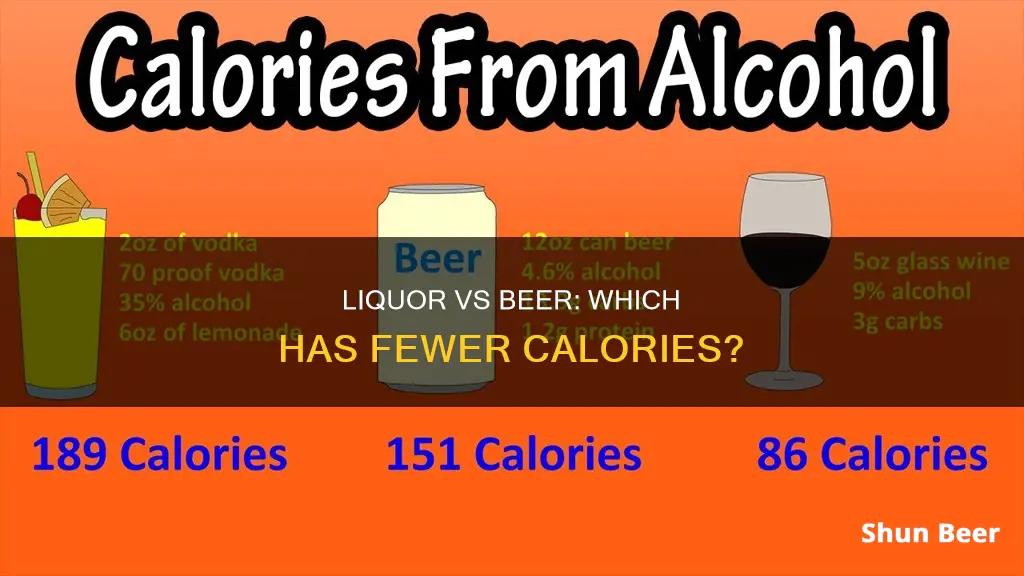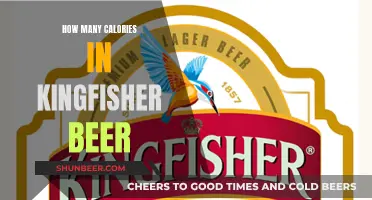
Alcoholic drinks are often high in calories and can contribute to weight gain. Pure alcohol contains 7 calories per gram, and the number of calories in a drink is influenced by its alcohol content, volume, and the presence of carbohydrates, sugars, and mixers. Beer and wine tend to have the lowest number of calories per ounce among alcoholic drinks, with light beers containing the fewest calories, at fewer than 100 calories for a 12-ounce bottle. A standard 12-ounce serving of 5% ABV beer usually has around 150 calories. Straight liquor generally has fewer calories than a 12-ounce beer, with a shot of straight liquor typically containing fewer calories and carbohydrates. However, the amount of calories in an alcoholic beverage can vary depending on its other ingredients, and mixed drinks tend to have the most calories.
Is liquor less calories than beer?
| Characteristics | Values |
|---|---|
| Calories in a 12-ounce beer | 150 |
| Calories in a shot of liquor | 97-98 |
| Calories in a mixed drink | 155 |
| Calories in a low-calorie beer | 55-100 |
| Calories in a cocktail | 160-200 |
What You'll Learn

Pure spirits contain fewer calories than beer
The type of alcoholic drink that is most fattening is usually the one with the highest calories and carbs. Cocktails often have the highest calorie count because of their sugar content. A Manhattan, for example, has around 160 calories per drink, while a Cosmopolitan has about 200 calories. Beer is not far behind, with an average of 149 calories per pint.
Beer is made from grain, which stores carbohydrates as starch. During the brewing process, these starches are broken down into smaller sugar pieces by enzymes in malted barley. While yeast converts the smallest sugar pieces into alcohol, some larger pieces remain, contributing to beer's overall calorie count.
Low-calorie beers have an additional enzyme added during brewing or fermentation to break down all starch molecules into simple sugars, leaving no remaining carbohydrates. These beers also have a relatively low alcohol content, further reducing their calorie count.
While pure spirits typically have no extra ingredients, many people dilute them with sweetened mixers, which can significantly increase the calorie count. For example, a 7-ounce rum and Coke has about the same number of calories as a 12-ounce beer.
If you're watching your weight, it's essential to be mindful of what you're drinking. Straight spirits, like vodka, gin, rum, and whiskey, have the fewest calories, while cocktails and beer are usually higher in calories. Additionally, it's crucial to remember that alcohol itself contributes to weight gain, and excessive drinking is associated with obesity.
Calorie Counting: Gin & Tonic vs Beer
You may want to see also

Cocktails are often high in calories
Cocktails are a fun and delicious way to enjoy a drink, but they can also be high in calories. The added ingredients in cocktails, such as soft drinks, syrups, juices, and sugars, can quickly increase the calorie count. For example, a Manhattan cocktail has around 160 calories per drink, while a Cosmopolitan has around 200 calories.
The high calorie count in cocktails is due to the combination of alcohol and added ingredients. Alcohol itself contains seven calories per gram, and when mixed with other ingredients, the calorie count can add up quickly. A 7-ounce mixed drink, like rum and Coke, would have about the same number of calories (155 calories) as a 12-ounce beer.
In addition to the alcohol content, the type of mixer used can also impact the calorie count. High-sugar mixers, such as Coke, Red Bull, or lemonade, can add hundreds of extra calories to your drink. Fresh fruit juices are a better option than syrups, as they contain fewer added sugars.
When watching your weight, it is best to avoid flavoured liquors and cocktails, as these often contain added sugars and sweeteners. Instead, opt for straight spirits or cocktails with low-calorie mixers, such as soda water, diet tonic, or fresh fruit juices.
While cocktails can be high in calories, there are ways to make healthier choices. Opting for low-sugar cocktails, such as a mojito without sugar or a Martini, can help reduce the calorie count. Additionally, making your own cocktails at home allows you to control the ingredients and choose lower-calorie options.
Overall, while cocktails can be a tasty treat, it is important to be mindful of their calorie content and make informed choices to maintain a healthy weight.
Ginger Beer: Low-Calorie, Healthy Fizz or Just a Myth?
You may want to see also

Beer and wine have the lowest number of calories per ounce
When it comes to alcoholic drinks, it's important to remember that they often contain high levels of calories and usually provide no real nutrients. Alcohol has more calories per ounce than carbohydrates or protein, and when combined with high-calorie foods, it can cause you to consume more calories overall.
Among alcoholic drinks, beer and wine tend to have the lowest number of calories per ounce. Light beers have the fewest calories, with many containing fewer than 100 calories in a 12-ounce bottle, though some have almost as many calories as regular beer. Regular beer contains about 140 to 200 calories per 12-ounce bottle. Red and white wine are also relatively low in calories, with dry wines containing minimal sugar. A glass of wine (5 ounces) typically ranges from 84 to 125 calories.
Hard liquor, such as rum, gin, whiskey, and vodka, usually has more calories than beer or wine. Each fluid ounce of 80-proof distilled spirits contains 64 calories, making a typical 1.5-ounce serving about 96 calories. Liqueurs tend to be higher in calories due to their higher sugar content. For example, a 1.5-ounce serving of chocolate liquor has 105 calories.
Mixed drinks also tend to be high in calories, especially those containing high-fat ingredients such as heavy cream or coconut cream. Cocktails mixed with soda, juice, cream, or ice cream can have especially high-calorie counts. A Manhattan, for instance, has around 160 calories, while a Cosmopolitan contains about 200 calories.
It's worth noting that the presence of carbohydrates in alcoholic beverages contributes significantly to their calorie content. Additionally, the bigger difference in calories between drinks usually comes from the alcohol content. Pure alcohol contains 7 calories per gram, which is more than protein and carbohydrates (4 calories per gram) but less than fat (9 calories per gram).
When trying to make healthier choices, it's recommended to stick to moderate consumption, which means no more than one drink per day for women and no more than two drinks per day for men.
Calories in Kombucha Beer: Nutritional Breakdown and Comparison
You may want to see also

Calories in beer and wine are derived from different sources
Beer and wine are two of the most popular alcoholic drinks worldwide. While both drinks contain calories, the number of calories and their sources differ between the two.
Calories in Beer
Beer is made from grains and yeast, and the calorie content can vary depending on the type of beer. On average, a pint of 5% ABV beer contains around 150 calories, but this can range from 60 to 300 calories depending on the brand and style. Lighter-coloured beers tend to have fewer calories than darker beers because they have a lower alcohol content and lower ingredient density. For example, most light beers have between 60 and 120 calories, while dark beers have between 100 and 300 calories due to their higher carbohydrate content.
Calories in Wine
On the other hand, wine tends to have a slightly lower calorie content than beer. A standard 175ml glass of 12% ABV wine contains around 133 calories, which is equivalent to about 100-120 calories per serving. Red wines typically have 25 calories per ounce, while white wines have 24 calories per ounce. Rose wine has around 70-80 calories per 100ml, white wine has 73-83 calories per 100ml, and red wine tends to contain between 75-85 calories per 100ml. The type and colour of wine can significantly impact the calorie content, with red wine usually having a higher alcohol content and more calories than white or rose wine.
Sources of Calories in Beer and Wine
The calories in beer come mainly from leftover carbohydrates, while wine has a relatively low sugar content. Beer also contains protein, fibre, B vitamins, folate, and niacin, providing some nutritional value. Wine, on the other hand, does not contain fat and has only trace amounts of protein, making the calories from wine "empty calories". However, red wine specifically contains high levels of antioxidants, which have been linked to improved heart health and a reduced risk of certain types of cancer.
Factors Affecting Calorie Content
It is important to note that the calorie content of both beer and wine can vary widely depending on factors such as alcohol percentage, brand, and style. Additionally, the way drinks are consumed can also impact calorie intake. For example, cocktails made with wine or spirits can significantly increase calorie intake due to the addition of sugary mixers.
Calories in M43 Beer: Understanding the Nutritional Breakdown
You may want to see also

Low-calorie beers have additional enzymes
Low-calorie beers are a great option for those who want to enjoy a drink without piling on the pounds. These beers have fewer calories and carbs than their regular counterparts, making them a more weight-conscious choice. But did you know that low-calorie beers also contain additional enzymes?
Enzymes play a crucial role in the brewing process. They are complex organic substances that act as catalysts, accelerating reactions without being changed themselves. During the germination stage of malting, enzymes are formed and activated, breaking down complex substances into simpler ones. This process is crucial for creating a well-modified malt that will result in a smooth and flavourful beer.
One of the key enzymes in low-calorie beers is ß-glucanase. This enzyme breaks down ß-glucan, a cell wall material, into simpler substances. By doing so, it reduces wort viscosity, improves beer fineability and filterability, and aids in Mash Tun run-off. Another important enzyme is amylase, which is essential for stabilising the alpha-amylase enzyme. Alpha-amylase is an endo-enzyme that cleaves internal a-1,4-glucosidic links in gelatinised starch, while beta-amylase, which does not require calcium for stabilisation, cleaves external links to form maltose and non-fermentable sugars called dextrins.
The use of additional enzymes in brewing is common, and it offers several benefits. Enzyme cocktails like Trizyme are formulated to address various issues in the Mash Tun, such as increasing extract, reducing wort viscosity, and improving beer fining performance and head retention. One such enzyme is Amylo-Glucosidase (AMG), which can be added to reduce the amount of dextrins in the beer, resulting in a lower-carbohydrate product. However, AMG continues to work even after packaging, so brewers must be cautious.
Enzymes are also added post-fermentation to control chill-haze in packaged beers and increase their shelf life. These enzymes are proteolytic-based on papain and are highly effective in breaking down high-molecular-weight proteins that contribute to chill haze formation.
While the addition of enzymes is beneficial for creating low-calorie beers, it is important to note that excessive enzyme activity can be detrimental. High temperatures and pH levels outside the optimum range can destroy enzymes, so brewers must carefully control these factors during the brewing process.
In conclusion, low-calorie beers contain additional enzymes that aid in reducing calorie and carbohydrate content. These enzymes play a crucial role in the brewing process, from modifying the malt to improving filtration and increasing shelf life. However, brewers must carefully manage enzyme activity to avoid negative consequences.
Natural Blonde Beer: Calorie Count and Nutrition Facts
You may want to see also
Frequently asked questions
Yes, liquor has fewer calories than beer. A standard 12-ounce serving of 5% ABV beer has around 150 calories, while a shot of straight liquor typically has fewer calories.
The amount of alcohol, the total volume of the beverage, the amount of carbohydrates and sugars, and any mixers all influence the calorie count.
Yes, cocktails often have the highest level of calories due to the sugar content. A Manhattan has around 160 calories per drink, and a Cosmopolitan has around 200 calories.
Yes, light beers are a good option, with many containing fewer than 100 calories per 12-ounce bottle. Low-calorie beers can have as few as 55 calories per beer. Hard seltzers are another low-calorie option, with brands like White Claw and High Water offering around 95-98 calories per can.
It's important to be mindful of what you're drinking and choose lower-calorie options when possible. Avoid sugary cocktails and opt for spirits with low-sugar mixers such as soda water or diet tonic. Eating a sizeable meal before drinking and staying hydrated by alternating between alcoholic and non-alcoholic drinks can also help reduce overall calorie intake.







